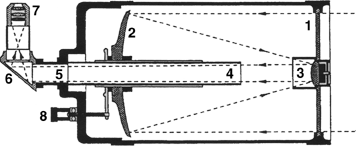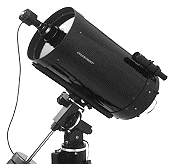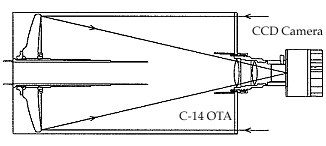Celestron History
![]() Distribution
Distribution ![]() News
News ![]() Notes & Interesting Articles
Notes & Interesting Articles ![]() Products
Products ![]() Pricing
Pricing ![]() Quality Assurance
Quality Assurance

Celestron C-14 "Fastar" Schmidt-Cassegrain Telescope Optical Tube
The Celestron 14" (356mm) Schmidt-Cassegrain telescope (SCT) is almost certainly the largest aperture, reasonably one man transportable equatorial telescope available. The largest of the production Celestron SCT's, the C-14 has a nominal focal length of 3910mm and a focal ratio of f/11*.
 Left: Cross section illustration of Celestron 8" Schmidt-Cassegrain optical tube assembly, this is similar to the C-14 arrangement (20,116 bytes).
Left: Cross section illustration of Celestron 8" Schmidt-Cassegrain optical tube assembly, this is similar to the C-14 arrangement (20,116 bytes).
Light enters through the Corrector Lens (1), then is reflected from the perforated Primary Mirror (2) at the rear of the telescope tube forward to the Secondary Mirror (3).
Light is then reflected from the Secondary Mirror back through Primary Baffle Tube (4) beyond the Rear Cell (5). Illustration shows the Rear Cell with accessories attached: 90 degree Zenith Prism (6) (or Mirror) diagonal, and an Eyepiece (7). The current production C-14's include a 2" Mirror diagonal instead of the shown 1.25" prism; the image will be presented to the observer appearing right side up, but reversed left to right.
The Focus Control Knob (8) is rotated clockwise or counter clockwise to move the Primary Mirror forward towards, or to the rear away from the Corrector Lens and Secondary Mirror; this will adjust the position of the focal plane beyond the rear cell of the telescope optical tube assembly where an eyepiece for viewing or a camera for imaging are attached.
The aperture of the Celestron 14" has about 306% more light gathering power than a comparable 8" Schmidt-Cassegrain telescope, and 96% more light gathering power than a 10" telescope. While the views of deep sky objects can be striking, the lunar and planetary detail is breathtaking too. The tremendous aperture and superb optics combine for thrilling "no imagination necessary" deep-sky observing of diffuse and planetary nebulae, open and globular star clusters, galaxies and binary stars. This instrument is the largest aperture one man transportable SCT made. With a suitable optional mount the system can be disassembled into components small enough to be easily carried or transported to remote sites for serious astronomical work. Experience scientific research quality optical performance which will provide awesome views of the planets, moon, and of the faint "deep sky" objects (including diffuse and planetary nebulae, open and globular clusters, galaxies, binary stars). In fact while many amateurs own the C-14, this is also a very popular choice for observatories, occultation work, remote site surveys, by University and research clients.
 Left: Celestron C-14 on optional German Equatorial Mount, with Fastar compatible CCD camera attached (16,334 bytes).
Left: Celestron C-14 on optional German Equatorial Mount, with Fastar compatible CCD camera attached (16,334 bytes).
Since September of 1998 all C-14 optical tubes provided from Company Seven are "Fastar" compatible. The Fastar system makes it possible for the C-14 to produce good results with extremely short exposure times of about 25 times faster than was otherwise possible at f11 prime focus. Covering fields of view with a Fastar 14 of up to 0.28 x 0.36 degrees - this is the equivalent of using the telescope as a 747mm f2.1 lens! The telescope retains its full visual capabilities at f11, and can also accommodate a variety of optional lenses at the axial port to vary the effective focal length and f ratio as fast as f4.
The Fastar system was originally announced in 1997 for the C-8 by Celestron. It is a joint development with the Santa Barbara Instruments Group who is well regarded for their advancements in the field of CCD imaging technology. The Fastar equipped telescopes incorporate a machined Secondary Mirror Holder with thread on retaining ring instead of the original plastic holder that was cemented onto the Corrector Lens. The assembly can be easily removed by the user in the field - with no tools being required to do so. The standard Secondary Mirror Holder with Secondary Mirror attached can now be removed, and then interchanged with an optional Fastar field flattening lens set provided with CCD camera holder. Even when the Secondary Mirror Holder with the Secondary Mirror is put back into place, since the hardware has an indexing pin and is mechanically well made the optical collimation of the system is retained.
 Above: Celestron Fastar CCD Camera Arrangement showing C-14 Optical Tube at left, with CCD Camera attached in Secondary Mirror position (20,355 bytes). |
The Fastar system is engineered to be compatible only with certain specific CCD cameras including: the Celestron Pixcel 255, Pixcel 237, SBIG ST-5 and ST-237 series. In addition, Company Seven offers optional Color Filter Wheel magazines for tricolor imaging with several of the compatible CCD cameras.
Company Seven makes the C-14 telescope optical tube assembly (OTA) available alone, or we can furnish it with your choice of suitable German Equatorial Mount. The German mount concept has advantages over the traditional fork mounted designs in that:
- the German mounts are less sensitive to the precise balance requirements of the fork mount
- avoids the risk of binding against the fork base when using accessories (such as CCD cameras with flip mirrors, etc.)
when working near the celestial pole - the German mounts allow one to quickly interchange telescopes so that one might be using the C-14 for small faint objects
and then later add a faster telescope for coverage of wide fields of view - the German mounts are so modular that the maximum weight of any one component is a fraction of what the fork mounted alternative might be. For example where a fork mounted 10" SCT has a weight of about 65 lbs, the heaviest part of a German mounted 11" SCT (such as the CG-11) is 31 lbs. On a C-14 system, even our large Astro-Physics Model 1200 mount the heaviest component remains no more than about 50 lbs.
A good value for visual use of the C-14 from a sheltered location (dome, etc.) is the Model G-11 German equatorial mount built by Losmandy's Hollywood General Machining Co. This combination of C-14 and G-11 was conceived for the astronomer who desires the maximum manageable portable light gathering optical system on an easily transportable tracking platform.
Many fine amateur astrophotographs and CCD images published have been taken using the C-14 OTA. And for a time Celestron was selling this telescope on the However, we are concerned that the Losmandy G-11 mount capacity with the C-14 OTA payload approaches the practical limits of use ability, and crosses the line for astronomical imaging, particularly if the telescope is to be employed at unsheltered, wind prone environments. And so Company Seven suggests the employment of proven mounts which are better able to anticipate technically demanding applications such as astrophotography, education, or research; such mounts include the Astro-Physics Model 900 or, ideally the Model 1200 Mount series, or our Losmandy Model HGM Titan mount. Company Seven also does offer the mounts made by Optical Guidance Systems (OGS) however, the prices for these systems really start in the low teens and so we do not sell very many of these or more costly alternatives while mounts such as the Astro-Physics and Losmandy are available. We and are quite pleased with the performance of the Astro-Physics Model 1200 and Losmandy HGM Titan and HGM-200 mounts when mated to a C-14, and we have an ever growing world wide base of such instruments in service with no customer complaints.
Company Seven now offers conventionally driven, and even more versatile computer controlled C-14 telescope systems that are based on implementing the Celestron C-14 optical tube assembly onto the proven Astro-Physics "GTO" computer controlled mounts. In particular we suggest you consider this option with either our Astro-Physics Model 900 or our Model 1200 series of Computer Controlled German Equatorial mounts. And we offer the computer controlled Losmandy series mounts using their own Gemini control system.
The Celestron C-14 telescope optical tube assembly includes:
The shipping dimensions of the C-14 OTA (accessories included): 38 x 25 x 23 inches; while the OTA weighs 50 lbs (22.7kg), the shipping weight of the OTA is about 110 lbs. (50kg),
Company Seven actually sells more C-11 and C-14 telescopes than we do C-8's since people who really want their system made well and properly set up value Company Seven's support. This is an observatory class instrument, and there are numerous options which you are likely to choose to buy initially with the telescope, and then many more can be added over time to further increase the versatility of this telescope. Please contact Company Seven for a much more in depth reply either by Email, or by telephone, or at our showroom.
*Specifications subject to change. The telescope can accommodate a variety of optional positive or negative lenses to vary the effective focal length and f ratio.
Quality Control: Company Seven is the only Celestron agent in North America who has the technological resources of experienced personnel and equipment to perform as detailed a survey of each instrument that arrives here for resale. The telescopes and mounts we offer are each so carefully examined and tested here that a failure is not likely to be found by our customer. Once at Company Seven, each telescope's optics, mechanics and electronics are checked by technicians each with between ten to more than thirty years experience!
Optional Evaluation/Characterization Services: While Company Seven does not routinely put each instrument on an interferometer, Company Seven can provide optional testing of any new optical tube assembly which we sell. Please contact us to discuss the cost our testing services. The testing will be performed as part of our acceptance testing prior to delivery of the telescope to the customer. The evaluation reports will then be delivered with the telescope to the customer.
Our optional testing is done on a Zygo interferometer and provide a very accurate characterization of the telescope. Our normal testing is done at 632.8nm (others available). The test will be performed at full aperture, with the telescope optically aligned and set to infinity focus, The test will provide:
Celestron Schmidt-Cassegrain Telescopes 
14 inch aperture Schmidt Cassegrain optical tube assembly f11 of nominal focal length of 3900 +-50mm (at 1.25" foci), Starbright Coatings (Magnesium Fluoride AR coatings on corrector, enhanced Aluminum on Primary and Secondary Mirrors), Celestron 26mm Plossl ocular, Celestron 2" Mirror Diagonal, 1.25" reducer/accessory holder, 9x 50mm straight finder on standard mounting bracket, “D" Series compatible dovetail channel plate, footlocker style shipping case with foam block inserts.
Specifications of the Celestron 14" Schmidt-Cassegrain Telescope Optical System
Design
Schmidt-Cassegrain Catadioptric
Effective Aperture
14 inches, 355.6mm
Nominal Focal Length
154 inches, 3910mm
Nominal Focal Ratio
f11
"Fastar" Focus Focal Length
29.4 inches, 747mm
"Fastar" Focus Focal Ratio
f2.1
Primary Mirror
14.25" Diameter, f2.14, Radius 60" (1,524mm), Spherical of fine annealed Pyrex®
Secondary Mirror
3.5" (88.9mm) Diameter, Radius 17.6" (447mm), Amplification ratio 5.14, Spherical (final hand figuring yields a slight asphere) of fine annealed
Pyrex®
Corrector
0.211" (5.35mm) thick parallel, aspheric Schmidt curve on R1 and Plano R2, of low iron glass, Mgf2 AR coatings each side
Mirror Coatings
Celestron "Starbright®": 5 step multi layer
Central Obstruction
4.5" overall
Highest Useful Magnification
Approx. 840x
Lowest Typical Magnification
70x (0.68 degrees) with 2" 55mm Plossl (5.07mm Exit Pupil)
Resolution, Visual
Dawes Limit: 0.33 arc seconds
Stellar Magnitude Limit, Visual
About Magnitude 15
Resolution, Film
182 lines per mm at 410nm
Image Scale (CCD or Film)
0.014 degrees per mm
Light Gathering Power
2581X Theoretical. Approx. 1940X actual over human eye (with 7mm entrance pupil)
Near Focus
Approx. 100 feet (30.5 meters)
Optical Tube Dimension
Length 30" (76cm), Diameter 16" (40.6cm)
Back Focus
14 inches from Apex of Primary Mirror
Optimum Back Focus
Approx. 5.975" from rear of Axial Port
We would remain only Email or a phone call away to serve these needs under warranty, as well as advise and counsel the user.
Go to Price List
Go back to Celestron Products page
Contents Copyright 1994-2000 Company Seven All Rights Reserved

